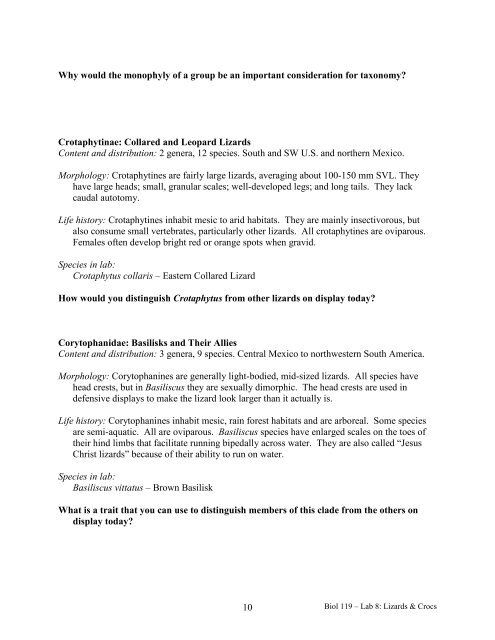Biol 119 – Herpetology Lab 8: Lizard and ... - Clark University
Biol 119 – Herpetology Lab 8: Lizard and ... - Clark University
Biol 119 – Herpetology Lab 8: Lizard and ... - Clark University
You also want an ePaper? Increase the reach of your titles
YUMPU automatically turns print PDFs into web optimized ePapers that Google loves.
Why would the monophyly of a group be an important consideration for taxonomy?<br />
Crotaphytinae: Collared <strong>and</strong> Leopard <strong>Lizard</strong>s<br />
Content <strong>and</strong> distribution: 2 genera, 12 species. South <strong>and</strong> SW U.S. <strong>and</strong> northern Mexico.<br />
Morphology: Crotaphytines are fairly large lizards, averaging about 100-150 mm SVL. They<br />
have large heads; small, granular scales; well-developed legs; <strong>and</strong> long tails. They lack<br />
caudal autotomy.<br />
Life history: Crotaphytines inhabit mesic to arid habitats. They are mainly insectivorous, but<br />
also consume small vertebrates, particularly other lizards. All crotaphytines are oviparous.<br />
Females often develop bright red or orange spots when gravid.<br />
Species in lab:<br />
Crotaphytus collaris <strong>–</strong> Eastern Collared <strong>Lizard</strong><br />
How would you distinguish Crotaphytus from other lizards on display today?<br />
Corytophanidae: Basilisks <strong>and</strong> Their Allies<br />
Content <strong>and</strong> distribution: 3 genera, 9 species. Central Mexico to northwestern South America.<br />
Morphology: Corytophanines are generally light-bodied, mid-sized lizards. All species have<br />
head crests, but in Basiliscus they are sexually dimorphic. The head crests are used in<br />
defensive displays to make the lizard look larger than it actually is.<br />
Life history: Corytophanines inhabit mesic, rain forest habitats <strong>and</strong> are arboreal. Some species<br />
are semi-aquatic. All are oviparous. Basiliscus species have enlarged scales on the toes of<br />
their hind limbs that facilitate running bipedally across water. They are also called “Jesus<br />
Christ lizards” because of their ability to run on water.<br />
Species in lab:<br />
Basiliscus vittatus <strong>–</strong> Brown Basilisk<br />
What is a trait that you can use to distinguish members of this clade from the others on<br />
display today?<br />
10<br />
<strong>Biol</strong> <strong>119</strong> <strong>–</strong> <strong>Lab</strong> 8: <strong>Lizard</strong>s & Crocs
















